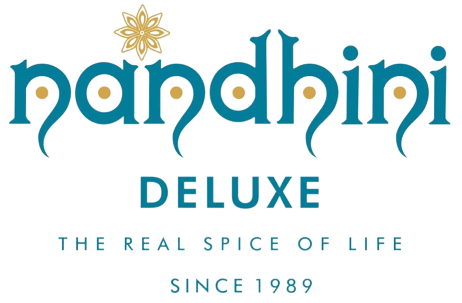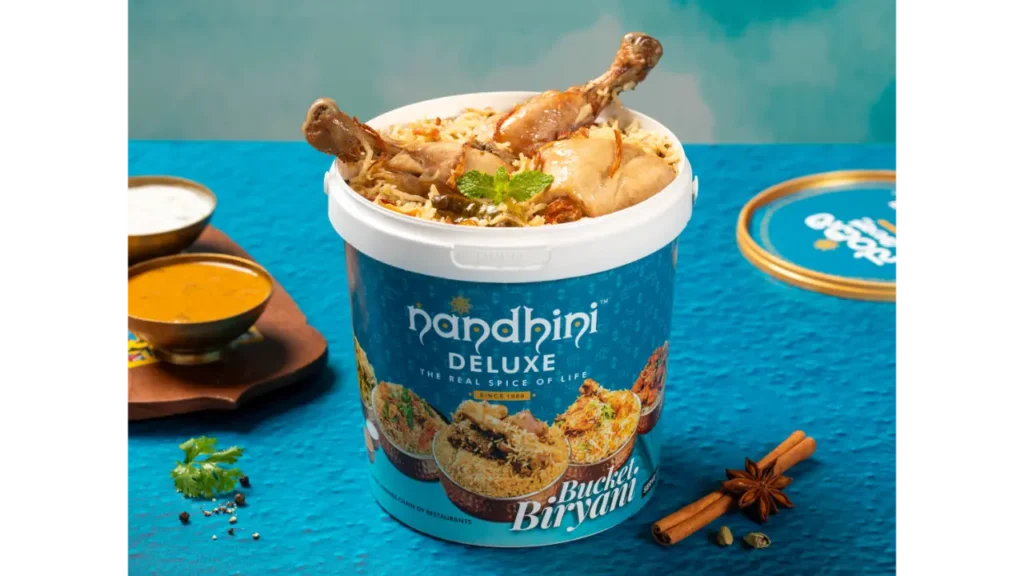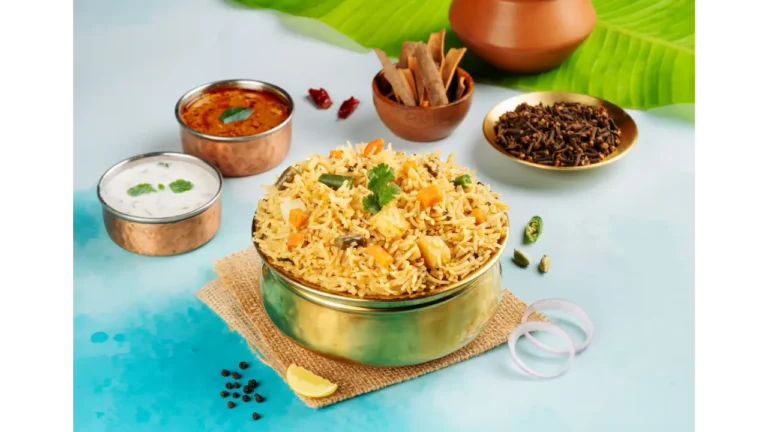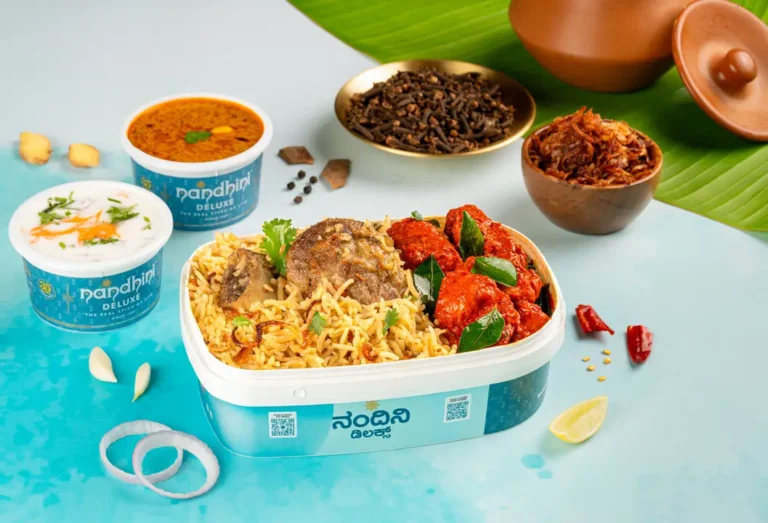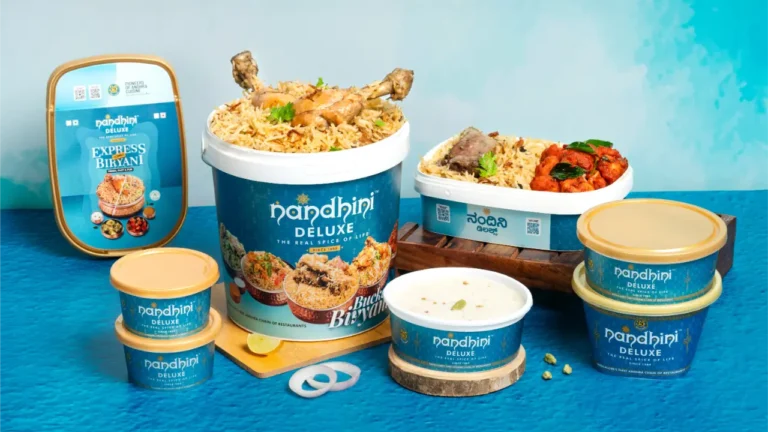Introduction
Bangalore diners often face a specific biryani dilemma: pick the chilli-led Andhra hotel style that traces to Nellore kitchens, or choose Hyderabadi dum for layered aroma and ritual. Both travel across the city’s tables, apps, and late-night counters, yet they answer different cravings. Andhra biryani leans on green and red chilli energy, tomato and onion body, and a direct cooking flow that keeps service quick. Hyderabadi biryani invests in time and layering, letting a yogurt marinade, birista, mint, and long-grain basmati perfume the pot under a sealed lid.
Market context matters. The city already hosts Donne and Bhatkali cults, so a clear Andhra versus Hyderabadi lens reduces confusion and pogo-sticking between tabs. Side dishes steer expectations too. Andhra restaurants typically send biryani with raita and pickle or pachadi; Hyderabadi places often attach mirchi ka salan. Rice choice finishes the identity: contemporary Andhra outlets in Bangalore mostly standardize basmati for grain separation and delivery hold, despite historical short-grain references around Nellore.
Brand cues reduce decision friction. Nandhini Deluxe Restaurants positions itself as an Andhra specialist with wide coverage across the city, consistent spice signals, and recognizable biryani SKUs for chicken, mutton, and family packs. That combination of style clarity and branch reach helps mixed groups decide quickly and eat happily.
Key Takeaways
- Andhra or Nellore style suits diners who want high chilli heat, quicker service, and raita plus pickle or pachadi.
- Hyderabadi dum suits diners who want layered aroma, salan on the side, and a slower, ceremonial plate.
- Basmati dominates Bangalore service for both styles, though texture and fragrance express differently.
- For families, Andhra biryani plus extra raita moderates heat without diluting flavor identity.
- Nandhini Deluxe offers reliable Andhra signals, citywide access, and practical family-pack options.
Table of Contents
Who should pick Nellore vs Hyderabadi in Bangalore?
Start with heat, then move to aroma and sides. Andhra or Nellore style favors diners who enjoy Guntur-led intensity and a masala that sits visibly in the rice. The cooking predicate is straightforward: sautéed base, protein cooked through, then combined with rice for a cohesive, punchy plate. Expect raita and a pickle or pachadi that tames heat while sharpening the palate. Service cadence is fast, which suits office lunches and group orders that cannot wait.
Hyderabadi dum favors diners who prize fragrance, length of grain, and a layered bite that changes from spoon to spoon. The pot is sealed after parboiled basmati meets marinated meat, birista, mint, and sometimes saffron. The result is structured and aromatic. Salan and raita anchor the sides, nudging the meal toward a sit-down experience.
Decision shortcuts help tables reach consensus. Spice seekers choose Andhra; aroma seekers choose Hyderabadi. Mixed groups can split orders and stabilize the Andhra plate with extra raita or curd rice. Bone-in mutton often shines in both styles, yet Andhra kitchens carry a reputation for robust chicken fry-piece variants that deliver immediate flavor. For delivery, basmati in either style holds up, but Andhra’s direct method often arrives more consistent when transit is long. If salan is non-negotiable, Hyderabadi wins by default. If pickle and pachadi are part of the comfort ritual, Andhra leads. Nandhini Deluxe’s Andhra focus and branch coverage make it a dependable choice for teams that want predictable spice and quick plating.
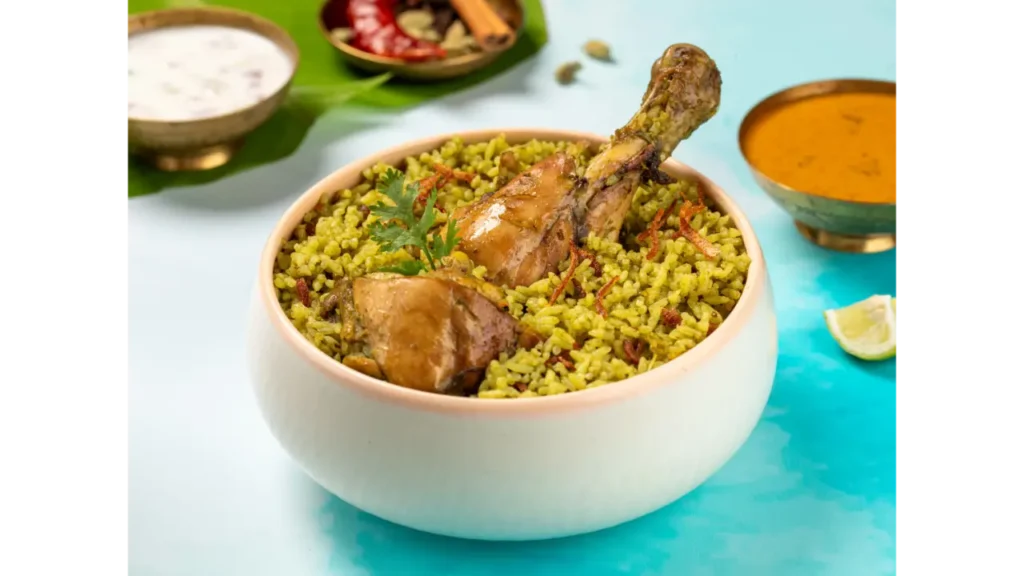
What defines Andhra (Nellore-style) biryani in Bengaluru?
Three signals define the plate: a chilli-forward masala, a practical hotel workflow, and Andhra-leaning sides. The masala typically builds on tomato, onion, ginger, garlic, green chilli, and a red chilli backbone associated with Guntur. Heat presents as direct and mouth-filling rather than perfumed. The protein, often chicken or mutton with bone for depth, is cooked to tenderness within this masala before meeting the rice, creating a cohesive bite where spice adheres to the grain.
Rice identity has shifted with urban logistics. While Nellore and other short-grain references remain part of the story, most Bangalore Andhra restaurants deploy basmati for length, separation, and delivery stability. That choice keeps the dish photogenic and prevents clumping in family packs. Fry-piece biryani appears frequently on Andhra menus, indicating seared or pre-fried meat pieces that carry concentrated surface flavor and slightly different texture compared to dum.
Sides complete the signature. Raita cools the palate; pickle or pachadi adds tang and punctuation. Andhra touchpoints such as gongura-based add-ons or ulavacharu specials may appear as seasonal or menu-adjacent notes that pair well with a spicy biryani. Service rhythm is pragmatic: high heat, clear flavors, quick plating, and reliable consistency across peak hours. In Bangalore’s multistyle ecosystem, this clarity positions Andhra or Nellore biryani as the go-to for diners who want an immediate chilli kick, familiar accompaniments, and minimal wait time. Nandhini Deluxe aligns with these cues, offering recognizable Andhra flavor markers and format options tailored to city dining patterns.
Hyderabadi biryani: technique, aroma, and salan logic
Hyderabadi biryani is defined by its dum predicate and a binary technique split. Kacchi layers raw marinated meat beneath parboiled basmati, then seals the vessel for a slow, steam-led finish. Pakki cooks the meat separately before layering with rice. Both paths elevate aroma through birista, mint, green cardamom, cloves, and saffron or kewra where used. Grain length matters here. The rice is parboiled to a measured doneness so the final steam sets each kernel long, dry, and fragrant, with separations that remain intact on the plate.
Flavor expression differs from Andhra hotel style. Heat is present but rarely leads. The top notes arrive as fried-onion sweetness, herbaceous freshness, and spice perfume. The mid-palate carries yogurt-tenderized meat and stock absorbed by the rice. Side ecology completes the experience. Mirchi ka salan brings roasted chilli depth and a sesame-peanut backbone that adds gloss and gentle bitterness. Raita cools and binds the plate, nudging the meal into a sit-down rhythm suited to unhurried dining.
Decision signals help tables navigate. Hyderabadi wins when a group values evolving spoon-to-spoon character, restrained heat, and a ceremonial pot opening. Bone-in mutton often showcases the style, with collagen and fat translating into a richer steam. Chicken performs well in pakki, where doneness is easier to control during rush hours. For delivery, tightly sealed dum pans hold fragrance if released promptly after arrival. For buffets, pakki batches maintain consistency across service windows. When salan is a must-have, Hyderabadi is the default pick. When a diner seeks a journey led by aroma rather than chilli intensity, Hyderabadi sets the benchmark.
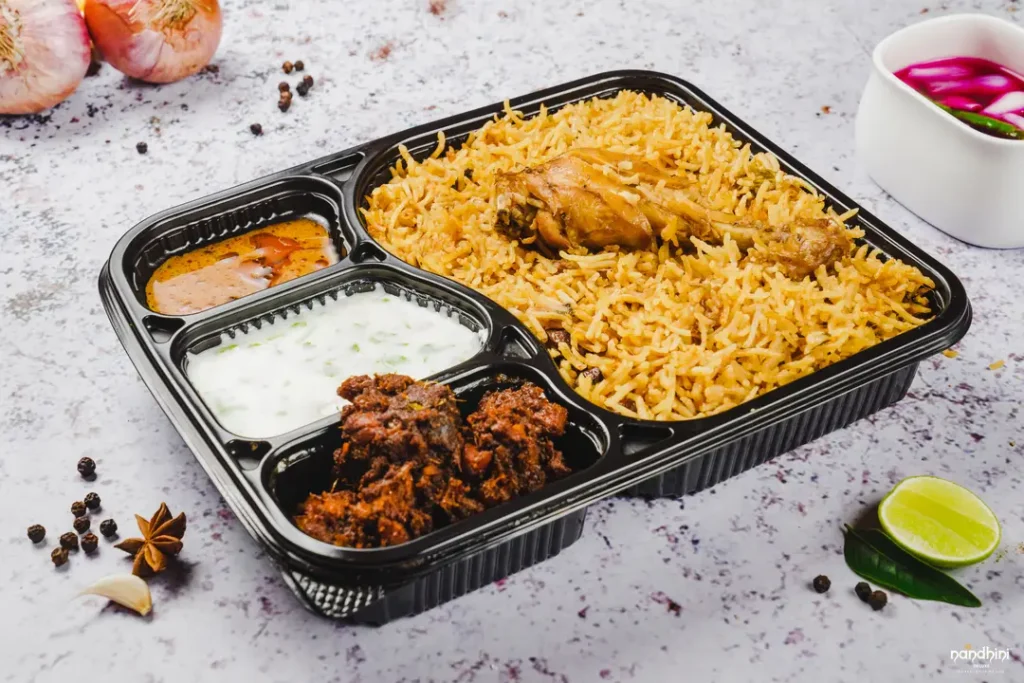
Bangalore reality check: Andhra or Nellore vs local Karnataka styles
Bangalore’s biryani ecosystem is plural, so comparisons prevent misorders. Donne biryani delivers a stock-forward, herbaceous profile with rice and meat cooked in a single pot, then served in leaf bowls that trap steam. The mouthfeel is moist and savory with coriander and mint weaving through each bite. Compared to Andhra, Donne trades chilli force for broth and herb lift. It suits quick-service counters and early lunches where a light yet savory plate is preferred.
Bhatkali biryani, rooted on the coast, often leans on a tomato and green chilli foundation with onions cooked to a soft, tangy-sweet glaze. The grain may not chase the long, dry separation of Hyderabadi dum, and heat presents differently from Andhra’s Guntur-led punch. Expect a balanced warmth rather than a sharp spike. Against Andhra or Nellore, Bhatkali feels rounder and less aggressive, with a saucier cling and coastal sensibility.
Hoskote and Raichur traditions add rustic cues, including assertive masalas and weekend crowd rituals. These formats influence expectations across the city but do not replicate Andhra or Hyderabadi predicates. Key pitfalls to avoid include expecting mirchi ka salan with Andhra hotel biryani or assuming Donne’s herb-laced stockiness signals Andhra lineage. Another common error is treating any chilli-forward biryani as Hyderabadi because of basmati length. In practice, modern kitchens across styles use basmati for logistics and visual appeal. Readers comparing plates should focus on technique verbs and sides: layered and sealed with salan implies Hyderabadi; sautéed masala integration with raita and pickle or pachadi implies Andhra or Nellore; leaf-bowl service with broth resonance implies Donne.
Where to order authentic Andhra biryani in Bangalore
Nandhini Deluxe Restaurants operates as a clear Andhra signal across the city, providing predictable spice, Andhra-leaning sides, and a menu that scales from solo orders to large family packs. Branch coverage reduces delivery distance, which improves grain separation on arrival. The kitchen grammar stays consistent: a chilli-forward masala anchored by tomato, onion, ginger, garlic, and green chilli; proteins cooked to tenderness within that base; rice integrated for a cohesive bite rather than layered perfume. Typical plates ship with raita and either pickle or pachadi, aligning expectations for Andhra hotel style.
Order mapping helps intent translate to the right SKU. Spice seekers often opt for chicken Andhra biryani or mutton Andhra biryani, with a boiled egg add-on to round the plate. Mixed groups stabilize heat by adding extra raita or plain curd rice. Family packs travel well due to basmati separation and thoughtful boxing, retaining texture during longer drives. Fry-piece variants deliver concentrated surface flavor and a firmer chew that stands up to transit, which is useful for late dinners or office sharing. Seasonal or menu-adjacent Andhra touches such as gongura items or ulavacharu-based specials can be paired to widen the flavor arc without reducing chilli character.
For a Hyderabadi-leaning evening, groups that still prefer Andhra heat can split the table between a dum biryani and an Andhra biryani, then calibrate bites with raita and pickle on one side and salan on the other. For celebrations, Nandhini’s catering options and branch network make bulk ordering practical, with predictable timelines and repeatable results. Diners seeking an unmistakable Andhra identity, dependable spice, and service cadence tuned to Bangalore’s pace find Nandhini to be a low-friction, high-satisfaction pick.
Ingredient intelligence: the Andhra signal set
The Andhra plate speaks in ingredients as much as in cooking flow. Guntur chilli anchors the heat profile, providing both intensity and a vivid red hue. Unlike milder northern varieties, Guntur delivers a sharp yet lingering burn that defines the palate of Andhra hotel biryani. Kitchens in Bangalore often calibrate the quantity to balance consistency across diners, but the chilli remains the unmistakable signature. Families sensitive to heat can request reduced spice or buffer plates with additional raita, though the underlying identity remains fiery.
Gongura, the sour sorrel leaf prized in Andhra cuisine, adds tang and depth when paired as a side or integrated into biryani variants. Its sourness lifts chilli heat, creating contrast rather than dilution. Gongura rice and gongura pachadi often appear alongside biryani spreads, giving the table an expanded spectrum of flavors. Ulavacharu, a horse gram stew with earthy undertones, surfaces in occasional biryani specials, underscoring the range of Andhra signals beyond spice alone.
Rice completes the triad of identity markers. While Nellore biryani historically leaned on short-grain varieties like jeeraga samba, basmati dominates in modern Bangalore service. The reasons are practical: basmati holds texture during delivery, photographs well, and scales easily across commercial kitchens. This shift makes grain length less of a differentiator between Andhra and Hyderabadi biryani in the city, though the masala expression still sets them apart.
Understanding these elements gives clarity to diners choosing Andhra biryani in Bangalore. Spotting the Guntur chilli punch, the occasional gongura sour lift, and the long-grain basmati format confirms the style and prevents confusion with Karnataka’s herb-heavy Donne or Hyderabad’s dum-sealed variants.
FAQs
Is Andhra biryani the same as Nellore biryani?
Nellore biryani is a prominent Andhra sub-style. In Bengaluru, Andhra hotel biryani often follows Nellore cues: chilli-forward masala, straightforward assembly, and service with raita plus pickle or pachadi.
Which is spicier: Nellore or Hyderabadi?
Andhra or Nellore expresses a sharper chilli punch, often linked to Guntur-led heat. Hyderabadi can be spicy but frames heat inside an aroma-first, layered profile.
What sides come with each style in Bangalore?
Andhra restaurants commonly pair raita and pickle or pachadi, with occasional gongura pairings. Hyderabadi service usually brings mirchi ka salan and raita.
Which rice is authentic for these styles in the city?
Modern service in Bangalore standardizes basmati for separation and delivery strength. Historical short-grain notes exist for Nellore, but long-grain dominates commercial plates.
What does fry-piece biryani indicate on Andhra menus?
It indicates meat pieces seared or pre-fried before integration, producing concentrated surface flavor and a firmer chew, distinct from the softer texture of dum-cooked layers.
Conclusion
Bangalore’s biryani landscape rewards clarity. Andhra or Nellore style prioritizes chilli-led power, a practical hotel workflow, and sides that sharpen the palate with raita and pickle or pachadi. Hyderabadi dum prioritizes aroma architecture, layered cooking, and the salan ritual. Both rely on basmati in city service, yet the experience diverges because technique verbs and side ecology pull flavor in different directions. Diners who want instant heat, quick plating, and a cohesive masala on every grain gravitate to Andhra. Diners who want fragrance-first bites, spoon-to-spoon variation, and a slower table rhythm lean Hyderabadi.
Decision confidence improves when selection ties back to group context. Office lunches, late-night deliveries, and mixed-spice gatherings benefit from Andhra’s fast cadence and predictable calibration. Celebratory meals that linger benefit from Hyderabadi’s dum theatrics. Rice length does not decide identity in Bangalore; the predicates of cooking and the side set do. Fry-piece cues, gongura sightings, and pachadi on the tray signal Andhra. A sealed pot, birista, and mirchi ka salan signal Hyderabadi.
Brand reliability shortens the path from craving to plate. Nandhini Deluxe Restaurants functions as a citywide Andhra beacon with branch coverage, family packs, and a kitchen grammar tuned to Bengaluru’s pace. The net effect is fewer second guesses at the table and greater satisfaction per order. With a simple lens—heat versus aroma, sides, and time-to-plate—diners can pick the right biryani for the moment and enjoy the style that best matches appetite, occasion, and company.
